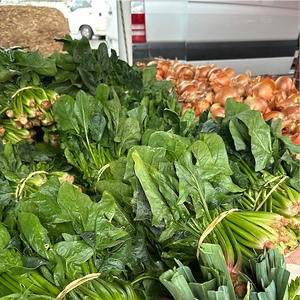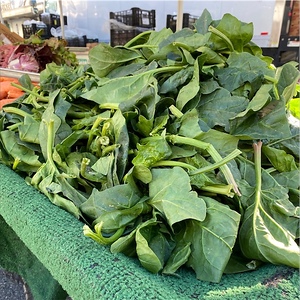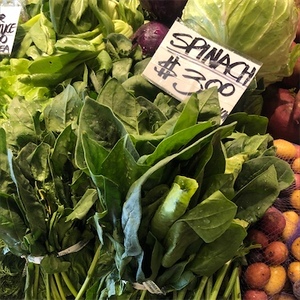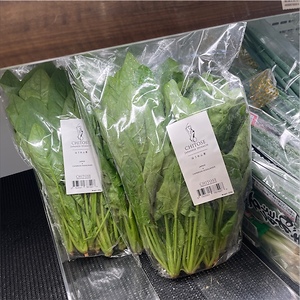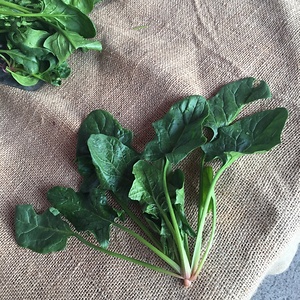


Arrowhead Spinach
Estimated Inventory, lb : 0
Description/Taste
Arrowhead spinach forms in rosettes that produce elongated, upright, and slender stems with multi-lobed, pointed leaves. The dark green leaves have 2 to 3 tapered lobes and are uniform in appearance, showcasing semi-serrated edges. The leaves are also smooth, thick, broad, and pliable, with deep veining across the surface. The stems are pale green, long, straight, and narrow with a smooth, firm nature. Arrowhead spinach has a crisp and succulent consistency. The stems are also edible and have a crunchy, lightly fibrous, and chewy texture. The greens have a mild, vegetal, and earthy flavor when raw and develop a tender, soft mouthfeel with nutty nuances when cooked.
Seasons/Availability
Arrowhead spinach is available year-round, with a peak season in the spring through fall.
Current Facts
Arrowhead spinach, botanically classified as Spinacia oleracea, is a general descriptor for several varieties belonging to the Amaranthaceae family. The name Arrowhead highlights the pointed nature of select spinach cultivars, and the leaves are generally smooth and flat-leafed with arrowhead-shaped leaves. Arrowhead spinach is cultivated worldwide and is also known as Asian-Leaf and Oriental Leaf spinach in select markets. The pointed greens are thicker than other spinach cultivars and are favored for their tolerance to hot and cold temperatures, slow-bolting nature, mild flavor, and multiple harvests. Arrowhead spinach can be harvested as baby greens or gathered at maturity, and the leaves are versatile, utilized in raw or cooked preparations. Popular varieties of Arrowhead spinach include Flamingo, Flamingo Improved, Summer Delight, Okame, Imperial Star Hybrid, and Regiment.
Nutritional Value
Arrowhead spinach is a source of calcium to build strong bones and teeth, vitamin C to strengthen the immune system and reduce inflammation, and vitamin K to assist in faster wound healing. The greens also provide vitamin A to maintain healthy organ functioning, iron to develop the protein hemoglobin for oxygen transport through the bloodstream, folate to produce healthy red blood cells, and other nutrients including manganese, fiber, potassium, magnesium, copper, and zinc. Spinach is valued for containing anti-inflammatory properties and antioxidants to protect the cells against the damage caused by free radicals.
Applications
Arrowhead spinach generally has a mild, earthy, vegetal, and nutty taste suited for fresh and cooked preparations. The greens should be washed before use and can be tossed into salads, a favorite preparation to highlight their pointed, unique leaf shape. Arrowhead spinach can also be layered into wraps, sandwiches, and burgers, blended into smoothies, stirred into dips, or mixed into grain bowls. In addition to raw preparations, Arrowhead spinach holds up well to cooked dishes and is used as a topping over pizza or wilted into pasta. The thick leaves can be steamed or sauteed as a simple side dish, cooked into egg-based dishes including omelets, quiche, and frittatas, or chopped and stuffed with herbs, spices, and other fillings into meats. Arrowhead spinach can also be simmered into soups, curries, and stews, used as a bed of cooked greens for seafood, or stir-fried with vegetables as a nutritious side. In Japan, Arrowhead spinach cultivars such as okame are sometimes used in gomae, also spelled goma-ae, a spinach salad. Gomae is comprised of blanched spinach tossed in a sauce of sesame seeds, sugar, water, soy sauce, and dashi powder. Arrowhead spinach pairs well with herbs such as thyme, basil, lovage, and dill, aromatics including garlic, ginger, shallots, and onions, mushrooms, potatoes, turnips, cheeses such as parmesan, feta, and cheddar, and nuts including pine, hazelnut, and walnut. Whole, unwashed Arrowhead spinach leaves will keep 5 to 10 days when stored in a sealed bag between layers of paper towels. The leaves can also be blanched or wilted and frozen for six months.
Ethnic/Cultural Info
Arrowhead spinach varieties are commonly used in Japan to make ohitashi; a boiled dish served in a dashi-based sauce. The word ohitashi is derived from hitashimono, translating from Japanese to mean “to immerse” or “to dunk,” a descriptor for the practice of serving the cooked spinach in a soy-sauce broth. Ohitashi dates to the Nara period and has appeared in written records throughout the Sengoku, Edo, and Meiji periods. Traditionally, the recipes incorporated foraged mountain vegetables or seafood in a sake or vinegar sauce, but the recipe was eventually adapted to include cultivated garden greens. Several kinds of vegetables can be cooked and served as ohitashi in the modern day, and spinach is one of the most popular due to its high nutritional content and ease of preparation. Over time, ohitashi has also been adapted to simply cook the greens and serve in soy sauce instead of a dashi-broth. Spinach ohitashi is customarily topped with dried bonito flakes, also known as katsuobushi, and is served with steamed rice, soups, and tofu.
Geography/History
Arrowhead spinach varieties are descendants of ancient cultivars native to areas of ancient Persia, now known as modern-day Iran. The edible, domesticated greens were thought to have developed through selective breeding of wild, leafy species, but much of the history of spinach is unknown. Over time, spinach was spread to neighboring countries around Persia, traveling through India, and was introduced into Nepal and China sometime before 647 CE. Spinach was also brought to Italy around 827 CE through the Arabs, and by the 10th century, the plant was found throughout the Mediterranean. Many Arrowhead spinach varieties were created in China and Japan and were sold for commercial cultivation and home garden use. They were also bred in the United States and were selectively cultivated as a variety that could withstand extreme temperatures without bolting. Today Arrowhead spinach varieties are grown worldwide and are produced on a smaller scale than other spinach cultivars. The fresh greens are offered through farmers markets, specialty retailers, and select grocers.
Recipe Ideas
Recipes that include Arrowhead Spinach. One
| Big Flavors From A Tiny Kitchen |
|
Baby Spinach and Cheddar Quiche |



